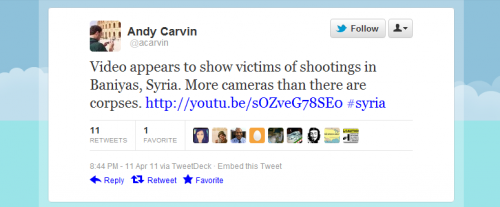This is part of a series of posts highlighting the Theorizing the Web conference, April 14th, 2012 at the University of Maryland (inside the D.C. beltway). See the conference website for information as well as event registration.
 Experiencing global events through social media has become increasingly common. For those in the West, the uprisings over the past few years in the Middle East, North Africa and elsewhere were especially striking because social media filled an information void created by the lack of traditional journalists to cover the dramatic events. By simply following a hashtag on Twitter, we tuned into those on the scene, shouting messages of revolution, hope, despair, carnage, persistence, misinformation, debate, sadness, terror, shock, togetherness; text and photos bring us seemingly closer to the events themselves.
Experiencing global events through social media has become increasingly common. For those in the West, the uprisings over the past few years in the Middle East, North Africa and elsewhere were especially striking because social media filled an information void created by the lack of traditional journalists to cover the dramatic events. By simply following a hashtag on Twitter, we tuned into those on the scene, shouting messages of revolution, hope, despair, carnage, persistence, misinformation, debate, sadness, terror, shock, togetherness; text and photos bring us seemingly closer to the events themselves.
But of course the Twitter medium is not neutral. It has shaped what we see and what we do not. Where is the truth in all of this? The intersection of knowledge, power, struggle and the radically new and transformative power of social media begs for intense theorizing. How we conceptualize, understand, define and talk about this new reality lays the path forward to better utilizing social media for journalistic and political purposes.
This is why the keynote for Theorizing the Web 2012 conference (College Park, MD, April 14th) features Andy Carvin (NPR News) and Zeynep Tufekci (UNC) in conversation. Carvin (@acarvin) has become well known for his innovative use of Twitter as a journalistic tool. Tufekci (@techsoc) has emerged as one of the strongest academic voices on social movements and social media and brings a theoretical lens to help us understand this new reality. Together, insights will be made that have impact beyond just journalism but to all researchers of technology as well as those outside of academic circles.
Who is Andy Carvin; and What Do We Call Him?
Without a deep background in professional journalism, Carvin’s actual title at NPR is “Senior Strategist.” However, during the recent Tunisian revolution, Carvin began interacting with Tunisian contacts on Twitter he made formed at previous job, a task that eventually crowded out much of his previous day job. Today, his work day is much different: In Andy’s words, “what I try to do is identify all the voices in the field involved in the revolutions and try to make a story out of it.” He explains further, “rather than spending the revolutions in country, with them, I spend my time online where they’re collaborating and congregating in order to get a sense of not only how social media is being used to organize each revolution, but also to have insights of the people on the ground who are using social media to communicate what’s going on.” Information on the ground is collected, sifted through, fact-checked, cross-referenced and vetted on his Twitter stream.
Carvin is not flying to the far-away places he reports on; nor is he embedded on-the-ground like the heroic journalist-image the term “foreign correspondent” sometimes conjures in our heads. Instead, Carvin is embedded at a cubicle, or often on his smartphone that his wife calls an extension of his palm. However, what Andy Carvin does smells a lot like journalism.
The scope of what Carvin is attempting is dizzying. The cacophony of voices shouting on social media during any major event in the 21st century can be deafening. To get a better sense of the scope of the Andy Carvin Experiment, @acarvin gets up to 2,000 @replies a day on Twitter. He guesses that he once tweeted 1,400 times in a single 20hour shift, which gives us an idea of the life of a Twitter journalist. The result has been what one site called “the words best Twitter account.”
That so many around the globe now have the tools to “report,” what some have called the rise of citizen journalism, means that massive amounts of data are being produced all the time. But simply shouting information is not journalism; those voices need to be made usable. What tweets are important? What tweets are true?
This verifying is precisely what Carvin is attempting to do. He relies on a large team of trusted contacts to help him source and vet information. While Andy Carvin is a human being, @acarvin is a network; the product of a large crowd checking facts, inserting their own knowledge, giving tips, garnering their own information, translations, and, perhaps most importantly, they correct Andy when he is wrong.
So that is Andy Carvin and this is where need to start theorizing. Do we have a new journalistic model, one that sits somewhere between the citizen on the ground and the gate-keeper at the top? The curatorial space in the middle might just be the future of journalism.
When a news story breaks, we can look to traditional, top-down outlets like The New York Times as well as finding information produced from the bottom-up by, say, searching a hashtag on Twitter. And we also have the new model positioned squarely in the middle, that space between “new” and “old” media that I have previously called “curatorial media.”
Carvin is Marshall McLuhan’s Goldilocks, finding the middle between one model that is too “hot” and the other too “cool.” Global Voices is another important example of curatorial journalism, creating a digest of the most important information on global events being posted across various social networks.
To Anticipate Carvin and Tufekci’s Theorizing the Web Keynote
 To close, we might think of some questions to frame this issue moving forward: What slice of the bigger picture do we get when relying on social media for journalism? An article in The Washington Post argues that Carvin is more likely to get information from rebels than regimes, thereby fundamentally biasing his data-source.
To close, we might think of some questions to frame this issue moving forward: What slice of the bigger picture do we get when relying on social media for journalism? An article in The Washington Post argues that Carvin is more likely to get information from rebels than regimes, thereby fundamentally biasing his data-source.
How do we best integrate Carvin’s feed with other, more traditional, journalistic sources to get a broader picture? What role does professional journalism still play when news-production tools continue to be further democratized?
How can this type of curatorial journalism be fast and efficient on the one hand (1,200 daily @replies?!) and accurate on the other?
Bring your own questions and insights to this keynote conversation in-person or via the #TtW12 backchannel. We will monitor the feed for questions before and during the event.
Nathan Jurgenson is co-chair of the Theorizing the Web conference. Follow Nathan on Twitter.




Comments 1
#TtW12 Keynote: Who is Andy Carvin? « n a t h a n j u r g e n s o n — June 19, 2012
[...] This post originally appeared on Cyborgology – read and comment on the post here. [...]